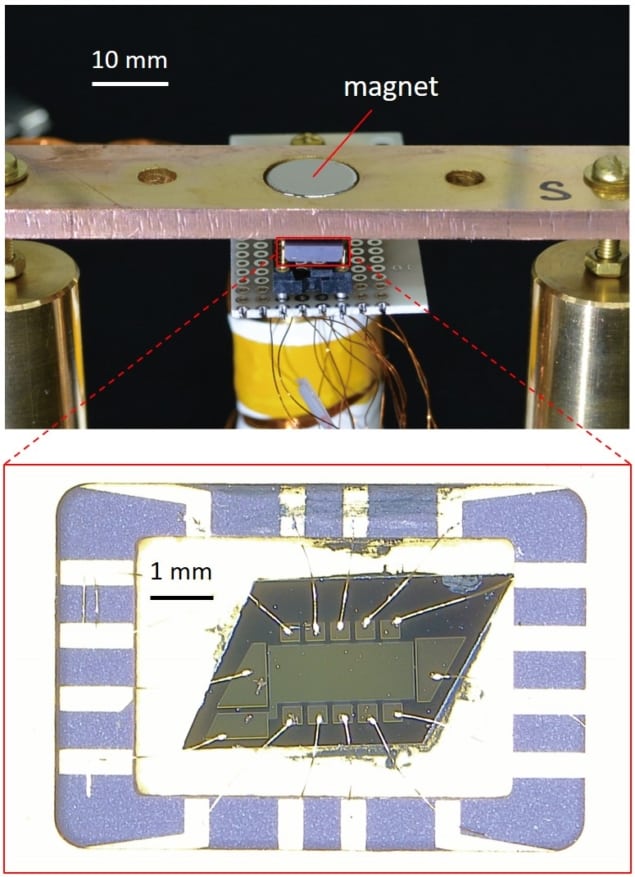
Researchers in Japan have proposed a new way of defining the standard unit of electrical resistance that would do away with the need for strong magnetic fields. The new proposal, which would create a standard based on the quantum anomalous Hall effect instead of the ordinary quantum Hall effect, would considerably simplify the experimental apparatus required to measure a single quantum of resistance.
Electrical resistance is a physical quantity that represents how much a material opposes the flow of electrical current. It is measured in ohms (Ω), and since 2019, when the base units of the International System of Units (SI) underwent their most recent revision, the ohm has been defined in terms of the von Klitzing constant h/e2, where h and e are the Planck constant and the charge on an electron, respectively.
To measure this resistance with high precision, scientists use the fact that the von Klitzing constant is related to the quantized change in the Hall resistance of a two-dimensional electron system (such as the one that forms in a semiconductor heterostructure) in the presence of a strong magnetic field. This quantized change in resistance is known as the quantum Hall effect (QHE), and in a material like GaAs or AlGaAs, it manifests at fields of around 10 Tesla. Generating such high fields typically requires a superconducting electromagnet, however, and the stray fields associated with such magnets make it challenging to integrate a QHE-based resistance standard with the voltage standard (which is based on a separate phenomenon known as the AC Josephson effect).
No superconducting magnet required
A team led by Yuma Okazaki of the National Institute of Advanced Industrial Science and Technology (AIST) in Tsukuba, together with Minoru Kawamura of RIKEN in Wako and colleagues at AIST, RIKEN, the University of Tokyo and Tohoku University in Sendai, has now demonstrated high-precision measurements of quantized resistance without using a superconducting magnet. The researchers did this by basing their measurement on the quantum anomalous Hall effect (QHAE), a variant of the QHE that arises from electron transport phenomena recently identified in a family of materials known as ferromagnetic topological insulators.
Because the QAHE manifests itself as a quantization of a material’s resistance even at weak (or indeed zero) magnetic fields thanks to spontaneous magnetization, the team was able to obtain high-precision measurements of the quantized change in resistance using just a small, commercially available permanent magnet. In a study published in Nature Physics, the researchers report that they measured the quantized Hall resistance to a precision of 10−8 Ω–1. This contrasts with previous reports in which the measurement uncertainty was more than a few parts in 107, which was not accurate enough for QAHE-based measurements to serve as a primary resistance standard.
An important milestone
“Our result constitutes an important milestone towards superconducting-electromagnet-free quantum resistance standard,” says Okazaki, the study’s lead author. The key to obtaining such high-precision measurements, he explains, is an increase in the critical current at which the QAHE breaks down. This current is the upper bound of the electric current needed to sustain the quantized resistance, and earlier studies of the QAHE revealed that it depended on the quality of the ferromagnetic topological insulator film. “To improve its quality, we optimized the various parameters relevant to the film quality, such as its chemical composition and the temperature at which it is grown,” Okazaki says. “As a result, we obtain a critical current of about 1 microamp, which is one or two orders of magnitude higher than the values previously reported.”

New definition of the kilogram comes into force
The researchers note that in their present device, they were only able to observe the QAHE at temperatures below 0.1 K. They acknowledge that this is far from ideal, since achieving such low operating temperatures requires an expensive cryogenic system like a 3He/4He dilution refrigerator. Increasing this value to above 0.3 K would be helpful, Okazaki says, as such temperatures can be obtained with a more compact and lower-cost 3He sorption refrigerator. Further optimization of the growth conditions of the ferromagnetic topological insulator film, as well as using other host materials, could make such a temperature increase possible, he says.



